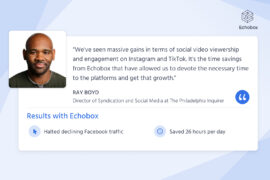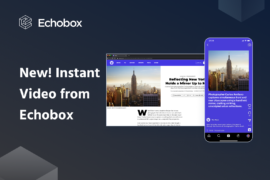Growing your traffic on Facebook is one of the key planks in a successful social media engagement strategy, but it’s easier said than done. Facebook remains the single most important source of social media traffic for content creators in many industries around the world, accounting for around 13% of all pageviews according to the Social Media Index, a free tool we’ve developed to track traffic to the websites of content producers in the media sector from social media platforms. To put this figure into context, Instagram, Twitter, LinkedIn, Reddit and Pinterest combined make up only 1.6% of traffic. Producing a strong engagement strategy for Facebook, therefore, is vital.
So how can you optimize your social media strategy on Facebook? How should you format your posts? Does adding tags increase clicks? When should you share your posts? In the aggregate, the answers to these questions can add substantial numbers to your traffic. We know, we’ve done the research. Our Data Science team are always on the lookout for tests to run, numbers to crunch and trends to analyze, and the fruits of their labor are our white papers, rich in insights into the best strategies to optimize your social media strategy.
Here are 9 key recommendations derived from our research covering all aspects of posting, from how to format posts to whether to tag them and when to share them, all designed to help you take your social media strategy to the next level.
The right post format will boost social media engagement
So, you’re putting together your post. What should it look like?
1) Focus on link posts for more traffic: One of the most difficult aspects of developing a social media strategy is contending with Facebook’s algorithms.
In line with changes to its Feed algorithm, in 2017 Facebook announced that social media teams should share a mixture of link and photo posts, contradicting earlier advice to simply do what made most sense to each business. The advice seemed simple enough, but is there a specific ratio of link posts to photo posts that produces the best results? We looked into it and reached some surprising conclusions.
Partnering with 11 leading brands from around the globe, we conducted the largest ever scientific study on the issue and discovered that, in fact, Facebook’s own advice was incorrect: introducing photo posts produced diminished performance compared with sharing only link posts in the 4 key metrics we studied.
2) Make videos part of your social media strategy: For a long time, Echobox clients have been asking us for data on videos, and for good reason. With each passing day, the falling cost of specialist technology is making video content easier and cheaper to make, meaning that more and more businesses are starting to experiment with it.
In just the last few weeks, Facebook has announced that it is going to lean heavily into its short form Reels format, in an effort to compete with Snapchat for younger users. Meanwhile, YouTube announced that its own YouTube Shorts video clips are getting 1.5bn viewers a month — even more than Snapchat.
There’s clearly a market for video content, but what kind of results can you expect? We analyzed over 150,000 Facebook video posts published over the course of a year to produce a set of benchmarks for content producers, and the results were clear. Whereas the average CTR for organic link posts is 2.5%, for videos, the view rate (videos watched for at least 10 seconds) was a full 10 percentage points higher at 12.5%.

Of course, for many social media teams, organic link posts are a staple and we don’t mean that you should pivot your social strategy to focus only on video posts. But with a good mixture of different content types, you can potentially see amazing results when it comes to engagement overall.
What should your posts include for more engagement on social media?
Once you’ve determined your post formats, what content should your posts include?
3) Don’t overdo the emojis: We all love an emoji, and they’re a great way of forming a connection with your audience, but they’re best used sparingly in your social strategy. Our research concluded that including a single emoji in a Facebook post had significant benefits with those posts generating a 29% increase in pageviews over their emoji-less counterparts.
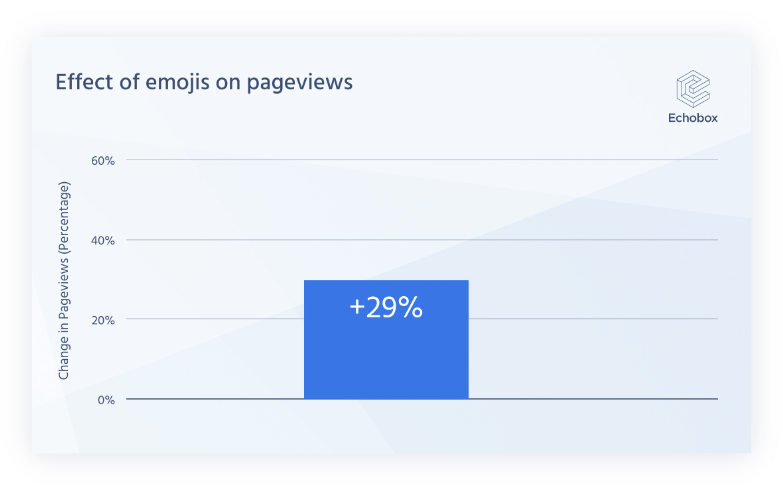
But these benefits steadily diminished with each extra emoji used, to the extent that posts with 3 emojis performed worse than those with none. In our white paper, we also looked at other variables such as positioning and the performance of certain popular types of emoji to develop a comprehensive guide to using emojis on Facebook.
4) A/B test for better results: While you may regularly use A/B testing in other areas of your marketing strategy, it’s one of the most underused elements in social media publishing. Yet testing can produce incredible returns. By getting an in-depth understanding of your audience — what they want and what they don’t even know they want — you can increase all kinds of metrics.
We published an ultimate guide for A/B testing to help any business conduct scientifically accurate experiments and gain reliable insights. One of the standout figures in our research was this: A/B tested posts have a CTR 32% higher than those posts that have been produced without testing. When the lessons from that testing are applied to all of your Facebook posts, that’s potentially a lot of extra referral traffic that can be generated.
Are tags on Facebook important for your social media strategy?
Your post is looking good. Should you tag it?
5) Think twice about that Breaking News tag: Theoretically, using Facebook’s Breaking News tag should be a really handy strategy for drawing a reader’s attention to important content. But does it really work? Our experiments determined that it did, but it came at a cost. Surprisingly, while articles tagged as Breaking News outperformed their predicted performance, overall Facebook traffic levels remained stagnant, or even decreased.
Why should this be? It seems that the effectiveness of the Breaking News tag is actually detrimental to other content, producing a so-called “cannibalization effect” which induces worse performance from non-tagged articles. Essentially, the Breaking News tag draws attention away from everything else. Therefore, while this tag can be effective when used judiciously, you should avoid generalizing its use in your day-to-day social media strategy.
6) Forget interest tags: Using data from some of the largest brands worldwide, all Echobox customers with many millions of Facebook followers between them, we looked at the effect of Facebook’s revamped organic targeting tool Audience Optimization. Specifically, we wanted to look at the impact on CTR of interest tags, which Facebook billed as extending the reach of content through more granular targeting.
We decided to put this to the test through training a machine learning algorithm to scan an article and produce a relevant and optimized interest tag (which was then reviewed by the page owner to ensure accuracy).
Our results showed that interest tagging has no effect on Facebook CTRs, neither positive nor negative. In fact, we found that even randomly tagging posts with irrelevant tags had no effect, either. None. You can therefore leave Facebook interest tags out of your social media strategy – you won’t miss out on performance gains.
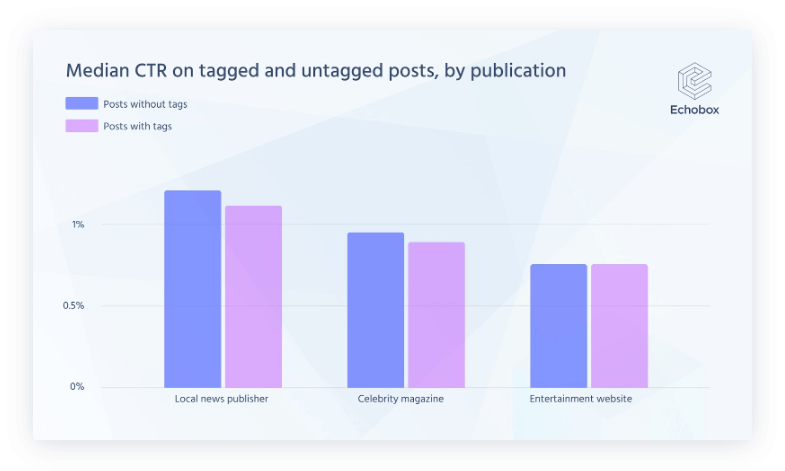
Timing and resharing = enagement
You’re ready to post, but when should you? And should you reshare content you’ve already posted before?
7) Get specific, there is no standard best time to post: There are many people who’ll tell you that they’ve discovered the best time to post; a time when everyone is online and checking Facebook and clicking through to your website, and if you post an article at that time, your engagement and clicks will go through the roof. They haven’t. No two businesses are the same, so why would they have the same peaks and troughs in audience engagement throughout the day?
Our study showed that each and every business has differing best times to post throughout the day that are specific to them, and that these times constantly change due to numerous factors. The only way to truly ensure that you’re choosing the best timing for your posts is to use an AI-powered social media management tool that continuously runs calculations on a minute-by-minute basis, ensuring that the right content goes out at the right time.

8) Be careful about post spacing: As we’ve mentioned before, one of the toughest aspects of developing a social media strategy that actually increases engagement on Facebook is dealing with Facebook’s ever-evolving Feed algorithm, designed to promote content that matches certain criteria. One of the most impactful but little known aspects of its workings is that the algorithm actively penalizes businesses who post at certain intervals — whether too often or too infrequently.
The intervals subject to penalization are non-linear and vary from business to business, meaning that there isn’t one standard posting frequency that ensures all your posts will perform well. But we’ve got you covered. We’ve developed the world’s first Facebook Grader for businesses to determine if post volume and frequency is helping or hurting them, and to analyze how their Facebook Pages are performing overall. Free to use, simply input the URL of the Page you want to examine, and we’ll send a report to your inbox detailing how that Facebook Page shapes up, along with tips for your Facebook strategy. Give it a go!
9) Reshare content, it’s incredibly effective: Making sure you have enough content to post throughout the day can seem forbiddingly difficult, but it’s really important. Leaving large gaps in sharing means that there are long periods where you aren’t maximizing your Facebook traffic. We looked at the benefits to be gained from resharing previously published content through a large-scale study involving 600 of the world’s leading content producers such as The Guardian, Le Monde and Conde Nast.
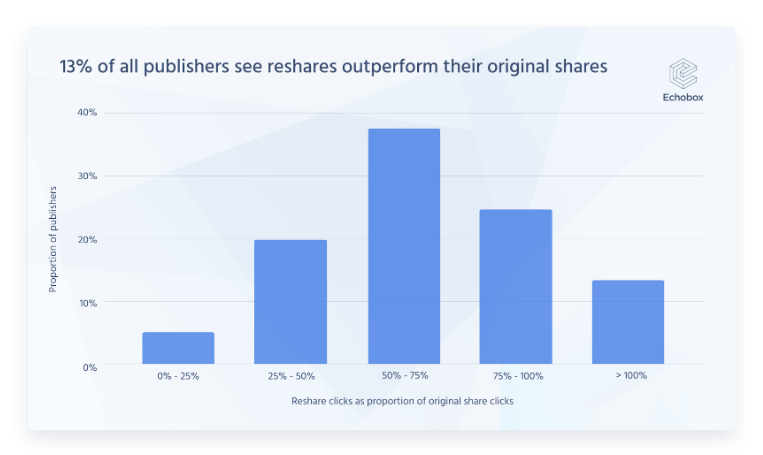
We found that, on average, reshared posts will garner around 67% of the clicks they did the first time around, making them a free and efficient means of driving significant additional traffic. Moreover, our study showed that for around 1 in 8, reshares actually outperformed their predecessors. Incredibly, over half of all businesses we studied failed to take full advantage of resharing in their social strategy, with 55% resharing under 10% of their content and an average reshare rate of just 8%.
Read our white paper for a step-by-step guide to how to best incorporate resharing into your social media strategy. When done effectively, there is no easier way to generate more traffic and engagement.
That’s it! Following these steps will help keep your Facebook shares prominent in the News Feed and save you time in the process. But there’s a way to save even more time and keep ahead of any potential changes to Facebook’s algorithm. Over 1000 businesses worldwide rely on Echobox to grow their presence on Facebook, Twitter, LinkedIn and Instagram. Get in contact today and see what Echobox could do for you!
Editor’s note: This is an update of an article originally published in September 2021

